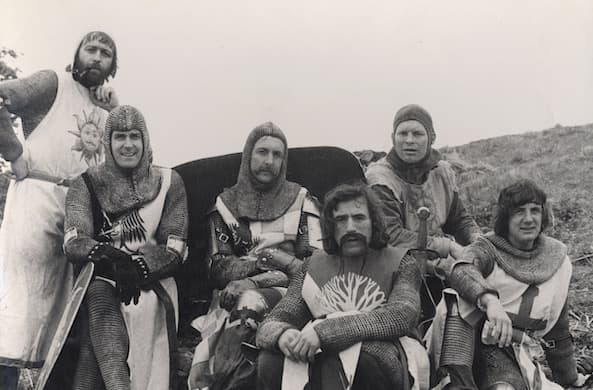Is ‘Monty Python and the Holy Grail’ Becoming Another ‘Rocky Horror Picture Show’?
Five-hundred theaters across the nation will feature ‘Holy Grail’ starting on December 3, and selected encore presentations will continue apace. Some venues will present a ‘Quote Along’ version of the film.

John Cleese, a notoriously fastidious man possessed of daunting comic gifts, has never liked the ending of “Monty Python and the Holy Grail” (1975). It “annoys me the most,” he told an audience at Indiana University at Bloomington, “… we couldn’t think of any other way” to end the film.
For those who haven’t watched this rousing tale of medieval conquest, its culminating battle is interrupted by an anachronistic raft of policemen who, upon driving into the battlefield, strong-arm Arthur, King of the Britons, into a paddywagon. Finally, one of the bobbies puts his hand over the camera’s lens with an admonitory, “That’s enough of that now.”
Seems perfectly reasonable — or, rather, unreasonable — to me. This was a film by Monty Python’s Flying Circus. Had Mr. Cleese been paying attention to what he and his comrades had been doing at the BBC for four anarchic seasons? Granted, a 90-minute film with a presumed storyline is a different animal than a half-hour sketch comedy show, but the non-ending of “Holy Grail” is part of a grand comedic tradition.
Mel Brooks did something similar with “Blazing Saddles” (1973) and the best Marx Brothers movies don’t end, they stop. W.C. Fields, a comedian of whom Mr. Cleese is an avowed admirer, finished off his comedies in a reliably desultory fashion, which is what you might expect of a man who, as legend has it, wrote his movie treatments on the backs of napkins while seated on the commode.
Contemporary viewers — that is to say, young folks conditioned by the disassociated herk-and-jerk of this-or-that video platform — may find the neo-Dadaist upshot of “Holy Grail” to their liking or, at least, a commonplace. They’ll have a stellar chance to see the film as it makes the rounds of theaters on the occasion of its 48th-and-a-half anniversary. Those of us who saw the film when it first opened can swallow hard upon considering the ineluctable passage of time.
Five-hundred theaters across the nation will feature “Holy Grail” starting on December 3, and selected encore presentations will continue apace. Some venues will present a “Quote Along” version of the film. “If you know, you know,” the press release reads. “The references are no longer just jokes. They are indelible fixtures in the pop culture zeitgeist.” Has the Python film really turned into a variation of “The Rocky Horror Picture Show”? Those wanting to avoid the sycophantic side of the group’s fan-base should take heed.
Why has the film garnered an unshakable following? “Life of Brian” (1979), the group’s follow-up to “Holy Grail,” is a more fully realized picture, and “The Meaning of Life” (1983) is an over-the-top revue punctuated by moments of brilliance.
“Holy Grail” is a more patchwork venture, owing, in significant part, to the Pythons’ cinematic naivete, but also to co-directors Terry Jones and Terry Gilliam having different interests as filmmakers. Jones concentrated on character and comedy; Mr. Gilliam, the phantasmagoric and the picturesque. This tug-of-war is evident in the film’s lop-sided shape and momentum.
The story, in so far as it is a story, involves King Arthur (Graham Chapman) and his loyal assistant Patsy (Mr. Gilliam) on a journey to enlist men for the Round Table. After much debate concerning whether swallows are capable of hefting coconuts, the Knights are ultimately assembled, including Sir Lancelot the Brave, Sir Robin the Not-Quite-So-Brave and Sir Not-Appearing-in-this-Film. Their adventures involve three-headed giants, requests for shrubbery, Tim the Enchanter and a rabbit whose appetite for human flesh is unappeasable.
What else do you need to know? The forever alluring Carol Cleveland, an indispensable component of the television series, is on hand as Zoot and Dingo, twin sisters at the fabled Castle Anthrax. The flummeries of cancel culture find a perfect corollary in a scene involving the criterions inherent to determining just who might be a witch and the inimitable Mr. Cleese hams it up as a truculent Frenchman.
There’s more, much more, to this galumphing mess of a movie. Best not to put off revisiting its byways, cockeyed ending or not.

